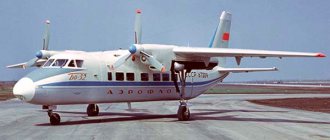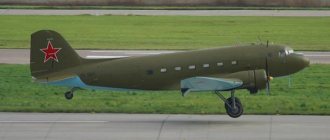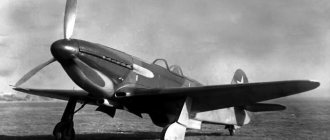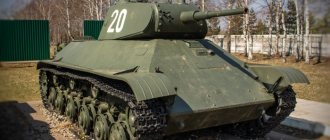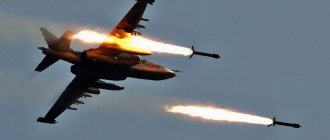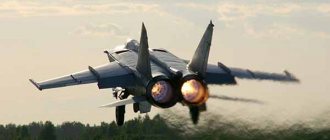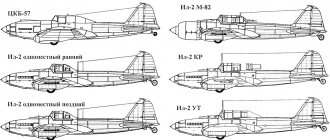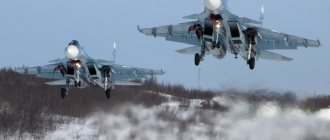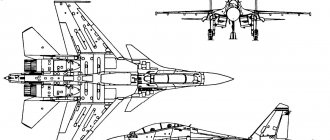For almost ten years, starting in 1973, at the OKB. A.N. Tupolev, various schemes for promising passenger aircraft were being worked on, united by the common code Tu-204. The very first project to receive the code Tu-204 was an aircraft project with two NK-8-2U engines installed in the rear fuselage. In 1975, a new Tu-204 project was proposed - with thundering engines. The work on the Tu-204 program at the OKB was led by chief designer L.L. Selyakov. In the course of further work, two projects remained - with two and three engines.
Tu-204 Engine. Dimensions. Range of flight. Practical ceiling. Fuel consumption. Price
For almost ten years, starting in 1973, at the OKB. A.N. Tupolev, various schemes for promising passenger aircraft were being worked on, united by the common code Tu-204. The very first project to receive the code Tu-204 was an aircraft project with two NK-8-2U engines installed in the rear fuselage. In 1975, a new Tu-204 project was proposed - with thundering engines. The work on the Tu-204 program at the OKB was led by chief designer L.L. Selyakov. In the course of further work, two projects remained - with two and three engines.
Bad places
If possible, avoid places near the toilet and those that do not recline. In the Tu-204 interior, according to the diagram provided by Red Wings, this is:
- 8 and 27 – completely. In these places, the backrest practically does not deviate, so as not to block the approach to the emergency doors.
- 35 C, D – aisle seats next to the toilets. During the entire flight, people passing or waiting in line will be disturbed here.
- 36 – completely. These seats have a blocked back, and the bathrooms are located immediately behind them.
Airplane Tu-204 - video
With the release of the USSR government decree on the creation of comfortable and competitive passenger aircraft, the design bureau began working on such an aircraft. OKB P.A. Solovyov was instructed to solve the problem with the power plant. Based on preliminary studies, various options for 2- and 3-engine aircraft layouts were considered. A.A. Tupolev and P.A. Soloviev relied on three engines, since engine designers could make an engine with a thrust of only 12-14 tons. Selyakov suggested that it would be advisable to slightly increase the engine thrust and make a car with two engines.
Based on the conditions for the speedy creation of a new aircraft with the arrival of an engine with a thrust of 12-14 tons, we decided to build an aircraft with three engines. After a series of discussions in 1979 at the NTS in MAP and MGA and by decree of the USSR government, a decision was made to implement the preliminary design of an aircraft with 208 seats. For two years, the design bureau has been working on a three-engine version of the aircraft. On August 11, 1981, the USSR government decree No. 782-230 was issued on the creation of a passenger aircraft with three D-90 engines. In 1982, a preliminary design was prepared and a mock-up of the aircraft was presented to the customer.
With the emergence abroad of new projects of passenger aircraft such as the Boeing-757 and -767, as well as the A-300, the new Minister of Aviation Industry I.S. Silaev demands speeding up work on creating new passenger aircraft that are not inferior to Western ones. According to the concept, the aircraft was supposed to be closer to the Boeing 757 and become twin-engine. LL insisted on this. Selyakov in the original project, as well as on maintaining the large diameter of the fuselage. Since this approach did not make it possible to obtain the fuel efficiency specified in the resolution with the existing engines, A.A. Tupolev firmly stood for the option of a normal fuselage diameter (about 4.0 m), and L.L. Selyakov asked to be released from leading the design of the Tu-204. L.A. was appointed the new chief designer. Lanovsky.
The new version of the aircraft also required a new technical specification. By that time, the thrust of the D-90 engine was increased to 16 tons, practically maintaining all the parameters of the previous one. Soon a new and final decree of the USSR government, dated January 18, 1986, on the Tu-204 aircraft with two engines will be issued. The serial plant that was supposed to produce the Tu-204 was the Ulyanovsk Aviation Association (now JSC Avia-star).
The aircraft performed its first flight on January 2, 1989 with a crew led by test pilot A.I. Talalakin. The main factory tests of the aircraft ended at the end of 1993. Based on the test results, it was concluded that the aircraft complies with the requirements of NLGS-3.
Modifications
Tu-204 is the basic version with a take-off weight of 94.6 tons. The first flight took place on January 2, 1989.
Tu-204-100 is a modification of the Tu-204 with increased take-off weight. Accommodates up to 210 passengers. Certified in January 1995. The maximum take-off weight of the Tu-204-100 is 103 tons, the flight range with 210 passengers on board is 4600 km.
Tu-214 (Tu-204-200) aviation
Tu-204-200 is a modification of the Tu-204-100 with additional fuel tanks for a longer flight range. Only one aircraft with tail number RA-64036 was built in Ulyanovsk. Produced in Kazan under the designation Tu-214.
Tu-204-100E is an aircraft with modernized equipment, an English-language flight deck, PS-90A engines and a maximum take-off weight of 105 tons.
Tu-204-100V is a modification created on the basis of developments on the Tu-204-100E with modernized equipment and a Russian-language cockpit.
Tu-204-100V-04 is a modification of the Tu-204-100V with PS-90A 4-stage engines that meet the requirements of Chapter 4 of ICAO Appendix 16 for local noise.
Tu-204-120 is a modification of the Tu-204-100/200, equipped with Western avionics and English Rolls-Royce RB211-535E4 engines (2x19500 kgf), which was created to expand the consumer properties of the aircraft. The first flight of this aircraft took place on August 14, 1992. The first customer of this type, as well as its cargo version Tu-204-120C, was the Egyptian airline Cairo Aviation. Deliveries to Egypt began in 1998 (five aircraft were delivered). The maximum take-off weight of the Tu-204-120 is 103 tons, the payload of the cargo modification of the Tu-204-120S is 27 tons, the flight range with 210 passengers on board is 4600 km. The aircraft complies with ICAO Annex 16 Chapter 3 noise standards and all other ICAO standards.
Tu-204-300 aircraft
Tu-204-300 (formerly designated Tu-234) is a variant with a fuselage shortened by 6 meters compared to the basic version and a significantly increased range. Accommodates up to 162 passengers, although the basic layout allows for 142 passengers (8 in business class and 134 in economy class). Developed in three versions with a flight range of 3400, 7500 and 9250 km. Thus, the Tu-204-300 is the first Russian twin-engine aircraft capable of making a non-stop flight to Vladivostok from Moscow and St. Petersburg. The maximum take-off weight of the aircraft is 107.5 tons. The Tu-204-300 is equipped with the Russian KSPNO-204 avionics complex and PS-90A engines (2x16140 kgf). The aircraft meets all modern and future requirements of ICAO and Eurocontrol, and has comfortable conditions for passengers, including an in-flight audio and video entertainment system. The Tu-204-300 made its first flight on August 18, 2003, and was then demonstrated at the MAKS-2003 aerospace show. The certificate of type and airworthiness was issued to the aircraft on May 14, 2005. The first customer of the Tu-204-300 was Vladivostok Air. Produced serially in Ulyanovsk.
Tu-204-300A with VIP-class cabin
Tu-204-300A - modification for administrative transportation. The maximum range with the estimated number of passengers on board has been increased to 9600 km. The aircraft is equipped with a high-comfort cabin, a shower cabin, a satellite communication system, adjustable main lighting and programmable full-color cabin lighting. Number of passenger seats - 26. Fuel filling - 42,000 kg.
Tu-214 (original designation Tu-204-200) is a modification of the Tu-204 with a maximum take-off weight increased to 110.75 tons (103.0 tons for the Tu-204-100) and a maximum payload increased to 25.2 tons (21.0 t for Tu-204). The first flight took place on March 21, 1996. The aircraft is certified according to Russian standards AP-25 (harmonized with foreign FAR-25 and JAR-25). In the fall of 1997, two aircraft under the designation Tu-204-200 began to be assembled at Aviastar in Ulyanovsk. Then serial production of this aircraft under the designation Tu-214 began to be carried out by the Kazan Aviation Production Association named after S.P. Gorbunov. Since April 2010, it has been produced only in special configurations; production of the commercial version has been discontinued.
Tu-214PU - aircraft of the Presidential Administration of the Russian Federation
Tu-214PU (control point)
Tu-214SR (relay aircraft)
Tu-214SUS (plane-communication center) - aircraft for the Administration of the President of the Russian Federation, equipped with special communications equipment
Tu-214R reconnaissance aircraft
Tu-214ON (“Open Skies”) is an aircraft with a digital aerial photo system, a side-scan synthetic aperture radar, infrared and television equipment, designed to carry out observation flights within the framework of the Open Skies Treaty.
Tu-204SM
Tu-204SM is an updated version of the Tu-204. Compared to the Tu-204-100, the maximum take-off weight was increased, the avionics were updated, which made it possible to reduce the crew to two people (without a flight engineer, which corresponds to world practice for aircraft of this class). Compared to the design of the basic aircraft of the Tu-204/214 family, the following main changes were made on the Tu-204SM aircraft: - modernized PS-90A2 turbofan engines with a reduced life cycle cost and increased overhaul and designated life of the main parts and assemblies (for the cold part - up to 20,000 cycles and for the hot part - 10,000 cycles); — new APU TA-18-200M with increased launch and operation altitude; new equipment is being introduced that performs functions in accordance with modern and future requirements of ICAO and Eurocontrol; — a modernized landing gear, the design of which provides a service life corresponding to the service life of the aircraft airframe; — the interior of the passenger compartment is improved; — a general aircraft equipment control system (CAE) and a maintenance and diagnostic system are being developed and installed; — cockpit, providing control of the aircraft by 2 pilots; — modified power supply, control systems, fuel and hydraulic systems, a new air conditioning system, a digital SCV system and electric drives are being introduced in the wing mechanization system. The tests of the new airliner took place with a slight delay: earlier at one of the press conferences, the general director of the aircraft plant, Sergei Dementyev, said that it was supposed to take off on December 17. However, work on assembling the remaining aircraft proceeded according to the planned schedule. In May 2013, the Tu-204SM completed a series of special and additional certification tests, during which 400 flights were performed. By decision of the IAC Aviation Register, an Addendum to the Type Certificate No. ST233-Tu-204-120SE/D10 dated May 31, 2013 was issued. In the first half of 2013, it was planned to begin serial production of the Tu-204SM, and from 2014 - the first deliveries of aircraft.
Tu-204-300-100 - the aircraft is a kind of hybrid of two modifications of the Tu-204 family, being an aircraft with the standard design of the Tu-204-300 in an extended version of the Tu-204-100. Passenger cabin layout: 94 seats, including eight luxury seats in the first cabin, 56 business class seats in the second cabin, 12 business class seats and 18 economy class seats in the third cabin.
Cargo modifications
Tu-204S - cargo modification
Tu-204S is a cargo modification of the Tu-204-100. Designed to transport cargo weighing up to 30 tons on air routes up to 2370 km long or cargo weighing 13.6 tons over a distance of up to 6820 km. Unlike the Tu-204-100, the Tu-204S has a cargo door with an opening of 3408×2080 mm on the left side; instead of a passenger compartment, a main cargo deck is formed, equipped with a loading and unloading system. On the cargo deck it is possible to transport cargo on standard pallets and in containers in various combinations. Below the main deck there are two luggage and cargo compartments. It is possible to transport long cargo up to 10 m long. The volume of the cargo compartment is 164.4 m3. The take-off weight of the aircraft is 107.5 tons.
Tu-204SE is a modification of the Tu-204S with modernized equipment and an English-language cockpit.
Tu-204-100S is a cargo modification of the Tu-204-100, equipped with a large cargo hatch in the front part of the fuselage. Flight range is 3900 km with a maximum payload of 30 tons. Take-off weight 110.75 tons.
Tu-204-120S is a cargo modification of the Tu-204-120 with a maximum payload of 21 tons.
Tu-204-120SE is a cargo modification of the Tu-204-120 with modernized equipment and an English-language cockpit. It was the first Russian-made aircraft to pass certification according to European standards and receive a type certificate from the European Aviation Safety Agency (EASA).
Airpark
The route network includes 35 destinations within Russia and abroad. The airline operates both regular and charter seasonal flights.
As of June 2022, Red Wings Airlines had 12 aircraft in its fleet. Of these, 6 are Russian Tu-204-100.
Tu-204 is a narrow-body passenger airliner designed for medium-range flights. Its development began in Soviet times at the end of the 80s at the Tupolev Design Bureau. The aircraft has been in serial production since 1990. As of 2022, a total of 72 Tu-204-100 have been produced.
Since 2000, the Tu-204 has had its cabins and passenger seats modernized, its avionics and a number of outdated service systems updated. The old aircraft control system indicators were replaced with liquid crystal ones. The use of the latest control systems made it possible to reduce the crew to 2 people, and technical solutions and improved design reduced the cost of maintaining the aircraft.
For passenger comfort, noise-absorbing materials and LED lighting are used in the cabin.
Tu-204 cockpit
Similar
An-24 Engine. Dimensions. Range of flight. Practical ceiling. Story
Tu-154 Speed. Dimensions. Weight. Capacity. Fuel consumption. Story
Yak-40 Engine. Dimensions. Capacity. Range of flight. Practical ceiling. Story
An-2 Engine. Dimensions. Story. Range of flight. Service ceiling
Tu-144 Engine. Dimensions. Range of flight. Practical ceiling. Story
IL-96 Speed. Dimensions. Capacity. Story. Load capacity
IL-62 Engine. Dimensions. Range of flight. Practical ceiling. Story
IL-18 Engine. Dimensions. Range of flight. Practical ceiling. Story
IL-14 Engine. Dimensions. Story. Range of flight. Service ceiling
An-14 Pchelka Speed. Dimensions. Weight. Capacity. Story. Load capacity
An-148 Speed. Price. Dimensions. Story. Capacity. Fuel consumption
Yak-42 Speed. Dimensions. Capacity. Fuel consumption. Story. Range of flight
Tu-114 Speed. Dimensions. Weight. Capacity. Story. Load capacity
Yak-12 Speed. Dimensions. Weight. Story. Capacity. Load capacity
An-3 Engine. Dimensions. Range of flight. Service ceiling
IL-114 Engine. Dimensions. Range of flight. Service ceiling
Yak-52 Engine. Dimensions. Range of flight. Service ceiling
Tu-334 Speed. Dimensions. Weight. Story. Capacity. Range of flight
Tu-134 Speed. Dimensions. Capacity. Fuel consumption. Story. Range of flight
IL-86 Engine. Dimensions. Range of flight. Service ceiling
Tu-204 Engine. Dimensions. Range of flight. Practical ceiling. Fuel consumption. Price
Tu-104 Engine. Dimensions. Story. Range of flight. Service ceiling
Su-29 Engine. Dimensions. Range of flight. Practical ceiling. Story
Su-31 Speed. Price. Dimensions. Story. Load capacity
Tu-124 Speed. Dimensions. Capacity. Weight. Story. Range of flight
Su-26 Engine. Dimensions. Range of flight. Service ceiling
An-10 Speed. Dimensions. Weight. Story. Capacity. Load capacity
An-140 Speed. Price. Dimensions. Capacity. Fuel consumption. Story
MiG-8 Duck Engine. Dimensions. Story. Range of flight. Service ceiling
Be-30 / Be-32K Engine. Speed. Dimensions. Range of flight. Service ceiling
An-38 Speed. Dimensions. Weight. Story. Capacity. Range of flight
Be-103 Speed. Price. Dimensions. Weight. Story. Capacity
IL-103 Engine. Dimensions. Capacity. Load capacity. Range of flight. Service ceiling
LK-1 (NIAI-1 Plywood-2) History. Dimensions. Engine. Range of flight
ANT-20 Maxim Gorky Speed. Story. Engine. Dimensions. Range of flight
Tu-110 Engine. Dimensions. Range of flight. Practical ceiling. Story
Yak-58 Speed. Dimensions. Weight. Story. Range of flight. Service ceiling
Aviatika-MAI-890 Engine. Dimensions. Speed. Range of flight. Service ceiling
Yak-50 Speed. Dimensions. Story. Range of flight. Service ceiling
Yak-55 Speed. Dimensions. Weight. Story. Range of flight. Service ceiling
IL-12 Engine. Dimensions. Story. Range of flight. Service ceiling
ANT-35 (PS-35) Engine. Dimensions. Story. Range of flight. Service ceiling
Airplane K-5 Engine. Dimensions. Story. Range of flight
KhAI-1 Engine. Dimensions. Story. Range of flight. Service ceiling
Yak-53 Dimensions. Range of flight. Weight. Service ceiling
MAI-223 Kitten Photo. Video. Characteristics. Engine
AIR-6 Engine. Dimensions. Story. Range of flight. Service ceiling
PS-89 (ZIG-1) Engine. Dimensions. Story. Range of flight. Service ceiling
SAM-5 Engine. Dimensions. Story. Range of flight. Service ceiling
Airplane Steel-3 Engine. Dimensions. Story. Range of flight
Airplane ANT-1 Engine. Dimensions. Story. Range of flight
Airplane U-8 Little Humpbacked Horse History. Dimensions. Engine
Airplane K-1 Engine. Dimensions. Story. Range of flight
Description of design
The Tu-204 is made according to a normal aerodynamic design; it is a cantilever low-wing aircraft with two turbofan engines, which are installed in pylons under the wing. The aircraft has a tricycle retractable landing gear with a nose gear. The wing mechanization of the Tu-204 consists of slats and double-slotted flaps.
Composite materials are widely used in the aircraft design, their share is 18%.
Tu-204 became the first domestic aircraft of this class with a fly-by-wire control system (EDCS).
The aircraft is equipped with a comprehensive information alarm system, which displays information on the operation of all aircraft systems on screens in the cockpit, warns of failures and malfunctions, and provides recommendations for their elimination. They also display the data necessary to pilot the aircraft. Moreover, information can be provided in both the British and metric units. The flight and navigation complex includes an on-board inertial navigation system, means for measuring altitude-speed parameters and angles of attack, landing systems, warning of critical conditions and collisions in the air, as well as a weather radar station.
The aircraft's fuel system consists of several caisson tanks, two of which are consumable. The total fuel mass is 35710 kg. An interesting feature of the Tu-204 design is the presence of a system for pumping fuel into the tail tank during flight. This allows you to shift the center of mass of the car and improve its aerodynamic characteristics.
The aircraft's power plant consists of two PS-90A engines, the maximum thrust of which is 16 thousand kgf.
A look at the Tu 204SM from the pilots' side
At first glance, this car is no different from its predecessors. But this is far from the case, it has all new filling, it is equipped with modernized and new systems. Improved engines, a new auxiliary unit, a lightweight landing gear - everything is aimed at ensuring that the aircraft complies with international ICAO standards.
As for safety, many accidents have occurred due to loss of spatial orientation, which occurs when switching to instrument flights from “direct” to “reverse” indication. On the Tu-204SM, the attitude indicator is made with a lateral roll scale and the transition to another indication occurs painlessly.
Disasters due to loss of speed have not yet been forgotten - these are the An-148 and the Airbus, which lost speed and crashed. On the new machine, this was taken into account, and now speed data is also taken from sensors located on the aircraft engines and standard sensors. This is a somewhat rough parameter, but now that the pilot sees the difference in the readings, he already understands the problem and has been trained in further actions.
After the accident with hockey players on the Yak-42, when the pilot tried to take off with the brakes pressed, a voice informer was installed on the Tu-204 SM, which, if the brakes were pressed during takeoff, provides information about the activation of the brakes.
The new aircraft has a fully implemented director flight control mode - from takeoff to landing. In this case, the pilot performs a backup function; the entire process is controlled by systems. The systems prevent the pilot from making a serious mistake or doing something involuntarily.
First the pilot must understand the problem, then turn off the control system and then only carry out the necessary actions.
The new Tu-204SM fully complies with the requirements of Airbus and Boeing, and even exceeds them in the number of control systems.
“This is exactly what needs to be developed”
Among the lucky few who managed to visit inside the “carcass” of the government airline were correspondents. Vasily Alexandrov, General Director of Vnukovo Airport, also came on board with us. We took advantage of this circumstance and asked him about the state of affairs in the business aviation sector and the prospects for domestic products.
General Director of Vnukovo Airport Vasily Alexandrov
“Vnukovo is famous for the fact that we have become leaders in this area of transportation; more than 70% of the business aviation traffic of the Moscow air hub passes through us. The pearl of our airport is the Vnukovo-3 Business Aviation Center. We constantly fly the most beautiful, fastest business jets,” our interlocutor noted. – Even in a crisis, planes fly. Despite the special economic conditions, this type of transportation continues and there is demand for it.” Consumers of business aviation services are a discerning public. At the same time, science, industry and design today are so developed that manufacturing companies are able to satisfy the most demanding client who is ready to incur the corresponding expenses, noted Vasily Egorovich. Meanwhile, there are a great many users of business class aircraft. The world fleet of business jets is about 18 thousand units. “If a client needs a shower, a bedroom, a wide cabin, a high ceiling, then the aircraft that SLO Rossiya is presenting at the exhibition will suit him.” It is distinguished by a modern interior created by Russian specialists. “In conditions of import substitution, this is exactly what needs to be developed,” says Vasily Alexandrov. The basic aircraft is well mastered by the flight crew. At the beginning of the century, more than a dozen narrow-body airliners developed by the Design Bureau named after. A.N. Tupolev were actively used on long lines connecting Moscow with the Far East. Khabarovsk Air (Dalavia) operated the Tu-214, Vladivostok Air operated the Tu-204-300.
Vasily Egorovich recalls: “Once, while traveling to the Far East, I talked with the crews of these airlines. And they told me that on long-distance routes, this aircraft is much more efficient than the Airbus. Serviceability level is higher. The flight time is more than four hundred hours per month on a serviceable aircraft. I note that 400 hours of flight time is very high. Therefore, it is necessary to produce more such aircraft so that those individual technical shortcomings, “incompleteness” in technology, like any new type of aircraft, are eliminated, the “roughness” is polished. Then the reliability will be even greater.”
Unfortunately, the age of the machine, the development of which took place in the eighties of the last century, makes itself felt. “I believe that this aircraft failed to materialize at the time it was released. This happened for certain reasons, I will not list them. As they say, there is no prophet in his own country. So: when the plane was first exhibited at the international air show, the foreign press wrote that the Tu-204 had the best wing.” “If you visit a large aviation museum, you can see many types of aircraft that were not produced in large numbers. But they became the basis for subsequent aircraft, more advanced, developed on the basis that was used as the foundation for development. So I think: the Tu-204 is precisely the foundation for the future development of next-generation aircraft. And the MS-21, which follows the Tu-204, will be a worthy continuation of its line.”
